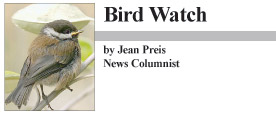Winter Bird Watching
 An intrepid group of about 20 birders went out to do the annual Christmas Bird Count on Dec. 28. Mid-winter is a challenging time to look for birds in Maine, and all fall, folks around here had commented on the scarcity of feathered visitors, especially at feeders. We suspected that mild weather had allowed birds to find enough food in their natural habitat so they did not have to visit feeders, and we hoped that we would find birds if we searched carefully for them.
An intrepid group of about 20 birders went out to do the annual Christmas Bird Count on Dec. 28. Mid-winter is a challenging time to look for birds in Maine, and all fall, folks around here had commented on the scarcity of feathered visitors, especially at feeders. We suspected that mild weather had allowed birds to find enough food in their natural habitat so they did not have to visit feeders, and we hoped that we would find birds if we searched carefully for them.
At the end of the day, we gathered to tally the results of the Count, and we were satisfied with both the number of species and number of individual birds. Here is our unofficial tally: 4 American black ducks, 85 mallards, 3 hooded mergansers, 3 ruffed grouse, 67 wild turkeys, 6 bald eagles, 1 northern goshawk, 3 red-tailed hawks, 1 rough-legged hawk, 2 gulls, 34 rock pigeons, 99 mourning doves, 19 downy woodpeckers, 16 hairy woodpeckers, 4 pileated woodpeckers, 1 northern shrike, 42 blue jays, 266 crows, 10 common ravens, 387 black-capped chickadees, 15 tufted titmice, 9 red-breasted nuthatches, 38 white-breasted nuthatches, 4 brown creepers, 4 golden-crowned kinglets, 58 American robins, 212 European starlings, 48 cedar waxwings, 18 American tree sparrows, 1 white-throated sparrow, 83 dark-eyed juncos, 200 snow buntings, 7 northern cardinals, 3 house finches, 37 pine siskins, 330 American goldfinches, and 44 house sparrows.
The day of the Christmas Bird Count, there was more open water than usual, but since then the lakes have frozen up and many streams and rivers are rimmed with ice. While it is tempting to think that all the water birds have abandoned us for warmer locales, some are still here, and the challenge is to find them. Last week, a private property owner invited me to watch birds on a large stretch of open water that is not easily seen from the road. As we walked down to the shore, we saw a large flock of mallard ducks spread out over the pond. Suddenly, the entire flock leapt off the water into the air. We looked up, and saw a bald eagle gliding overhead. The ducks flew only a short distance to the protection of a bridge before settling down again in a tight bunch, where it looked as if every duck hoped to be in the middle rather than exposed at the outer edge. Moments later, with no eagle in sight, they spread out again over the pond.
After I got home, I thought about the eagle and the ducks, and remembered something I had read in one of my favorite books about birds, The Wind Masters, The Lives of North American Birds of Prey, by Pete Dunne. Although the stories are fictional, they include an impressive amount of factual information based on the author’s extensive research and field observations of birds of prey. One story, about a pair of bald eagles in winter, takes us into the air with the male eagle, that has rejected the idea of feeding on a frozen deer carcass, which he considers to be inferior food. He watches the river from a high perch, and when he sees a flock of mallards on the river he leaves his perch, rises up in a series of thermals until he is invisible against the sky, and at the right moment begins to drop, using his powerful wings to gain speed. The ducks become agitated, then confused as the eagle flies parallel to the river rather than directly at them, and they bunch together for safety. At the last minute, when the eagle suddenly veers in their direction, the ducks panic and take to the air. One young mallard makes the fatal error of lagging behind, and is caught in mid-air by the eagle.
The scene we witnessed on the pond last week may be a regular occurrence. If the eagle glides overhead frequently, and if the ducks react in the same way each time, it is not difficult to imagine the eagle suddenly changing his strategy, the ducks flying up in panic, and a straggler being caught. We never know what we will find when we go out to look for birds. The challenge in winter is to go out and look.

